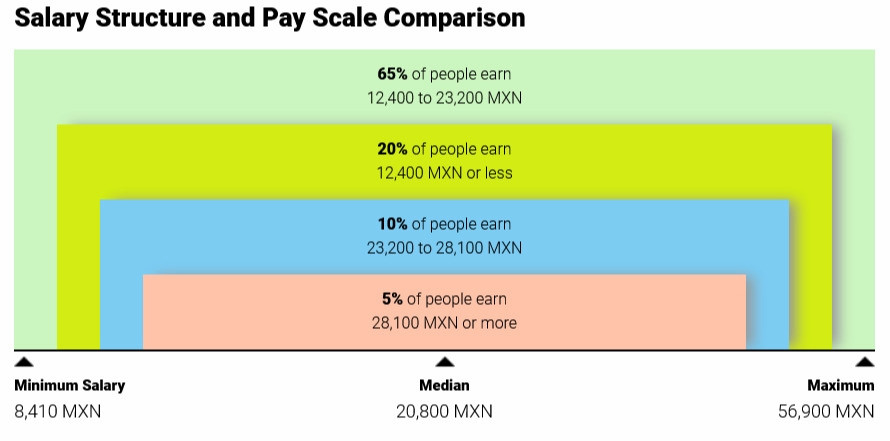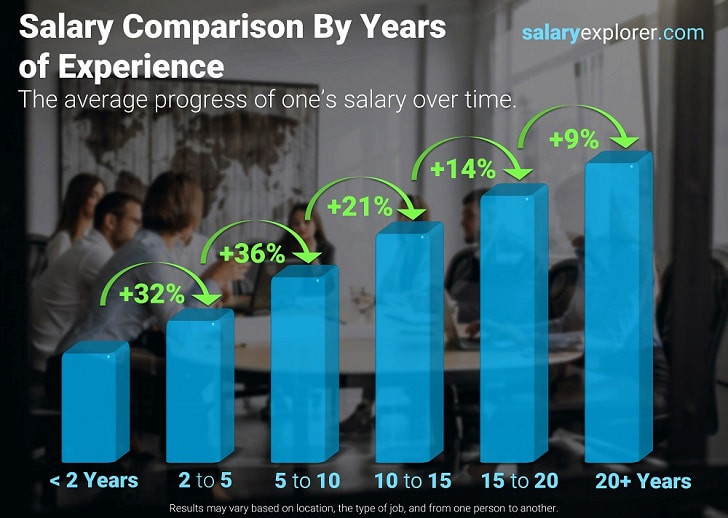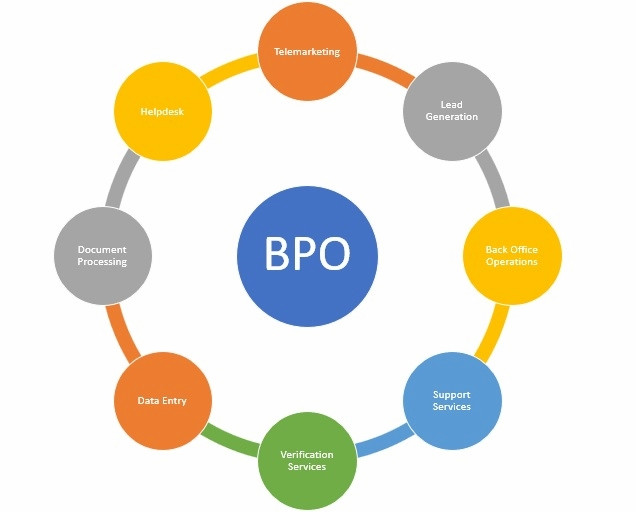Understanding the Average Wage In Mexico is crucial for anyone considering living, working, or investing in the country. As a key indicator of economic conditions and living standards, the average Mexican salary provides insights into various sectors, the cost of living, and Mexico’s position in the global economy.
This guide delves into the nuances of the average monthly salary in Mexico, examining the diverse factors that shape it, from education and industry to regional variations. We’ll also compare Mexican wages to those in other countries and explore the implications for outsourcing and investment.
What’s the Typical Monthly Salary in Mexico?
In 2023, the median monthly salary in Mexico hovers around 29,200 MXN, which translates to approximately USD 1,695.
While this figure provides a benchmark, it’s vital to recognize that the median income in Mexico is influenced by a wide array of elements. It’s also important to consider that the cost of living in Mexico is generally lower than in many developed nations, which impacts the purchasing power of these wages. Factors such as educational attainment, professional experience, and the specific industry and job type all play significant roles in determining individual salaries.
For a broader perspective, the average weekly salary in Mexico is about 4,500 pesos, and the average annual salary is roughly 205,000 pesos. Remember, these are averages, and actual earnings can differ substantially based on job specifics and location within Mexico.
 Understanding the average salary in Mexico: Key factors to consider
Understanding the average salary in Mexico: Key factors to consider
Key Factors Influencing Salary Levels in Mexico
Numerous factors contribute to the average salary in Mexico per month. Education level is a primary determinant, with higher qualifications typically opening doors to higher-paying positions. Experience in a particular field is also a major factor, as seasoned professionals often command higher salaries than those just starting their careers. The industry and specific job role are also critical, with sectors like finance, IT, and manufacturing generally offering more lucrative salaries compared to others.
Geographic location within Mexico also has an impact, as salary levels can fluctuate depending on the local cost of living and economic conditions. Understanding this complex interplay of factors is essential for gaining a clear picture of Mexico’s economic landscape and the financial well-being of its workforce. The distribution of salaries across the Mexican working population provides further context.
 Salary structure in Mexico and its distribution among workers
Salary structure in Mexico and its distribution among workers
Annual Salary Growth Trends in Mexico
Data from Mexico’s National Institute of Statistics and Geography (INEGI) indicates that the average nominal annual salary increase in Mexico during 2020 was 4.1%. This was slightly less than the 4.5% increase seen in 2019.
The slight decrease in salary growth in 2020 can be partly attributed to the significant impact of the COVID-19 pandemic on the Mexican economy. Many businesses were compelled to implement salary reductions, transition to remote work arrangements, or reduce their workforce in response to the economic downturn caused by the pandemic.
Over a longer period, the average annual salary increases in Mexico have shown some variability, generally ranging between 3% and 5% in recent years, with fluctuations influenced by overall economic conditions.
| Working Areas | Average Gross Annual Salary (MXN) |
|---|---|
| Administration | 265,144 |
| Agriculture, Food Industry | 252,398 |
| Arts & Culture | 282,281 |
| Banking | 405,048 |
| Car Industry | 320,634 |
| Chemical Industry | 328,726 |
| Commerce | 315,768 |
| Construction & Real Estate | 357,918 |
| Customer Support | 288,028 |
| Economy, Finance, Accountancy | 359,622 |
| Education, Science & Research | 297,293 |
| Electrical & Power Engineering | 339,294 |
| General Labor | 243,308 |
| Human Resources | 378,785 |
| Information Technology | 537,642 |
| Insurance | 340,244 |
| Journalism, Printing Arts & Media | 296,657 |
| Law & Legislation | 410,566 |
| Leasing | 479,812 |
| Management | 532,940 |
| Marketing, Advertising, PR | 356,468 |
| Mechanical Engineering | 327,937 |
| Medicine & Social Care | 290,935 |
| Mining, Metallurgy | 347,922 |
| Pharmaceutical Industry | 371,389 |
| Production | 295,375 |
| Public Administration | 338,754 |
| Quality Management | 375,527 |
| Security & Protection | 286,309 |
| Service Industries | 245,326 |
| Technology, Development | 449,701 |
| Telecommunications | 402,875 |
| Textile, Leather, Apparel | 206,351 |
| Top Management | 827,344 |
| Tourism, Gastronomy, Hotel Business | 252,570 |
| Translating, Interpreting | 314,514 |
| Transport, Haulage, Logistics | 281,359 |
| Water Management, Forestry, Env. | 315,901 |
| Wood Processing Industry | 270,808 |
Understanding the Daily Minimum Wage in Mexico
The National Minimum Wage Commission (CONASAMI), a Mexican government agency, is responsible for setting and adjusting the daily minimum wage rates across the country.
As of January 1, 2023, the daily minimum wage in Mexico is 185.56 pesos, approximately USD 9.31 based on current exchange rates.
This represents a significant 19% increase from the previous year’s daily minimum wage of 123.22 pesos.
It’s important to note that the daily minimum wage can vary based on geographic location and the worker’s economic sector. CONASAMI establishes different minimum wage rates for specific regions and industries, taking into account factors such as the cost of living and productivity levels.
Despite recent increases, many Mexican workers still earn wages that struggle to meet basic needs. According to data from CONEVAL, Mexico’s social development agency, approximately 41% of the population lives in poverty, with many in low-paying jobs that offer limited benefits or labor protections.
Mexican labor law provides workers with additional benefits beyond the minimum wage, including paid vacation time, social security contributions, and protection against workplace discrimination and harassment. However, the enforcement of these protections can be inconsistent, particularly within the informal economy where labor laws are often not applied.
High-Paying Industries in Mexico
Certain industries in Mexico are known for offering higher average salaries. The finance sector often leads the way, with roles in investment banking, financial analysis, and accounting being particularly well-compensated. The IT industry is another high-earning sector, where software development, cybersecurity, and data analysis positions typically command strong salaries. Manufacturing, especially in the automotive and aerospace fields, also provides competitive salaries.
Generally, industries requiring specialized skills and advanced expertise tend to offer higher salaries in Mexico. However, salary levels within any industry can vary significantly depending on location and experience. Thorough research into specific job roles and industries is crucial when considering career paths in Mexico.
 Salary variations based on experience levels in Mexico
Salary variations based on experience levels in Mexico
Companies Leading in High-Salary Sectors
 Employees working in a high-paying industry in Mexico
Employees working in a high-paying industry in Mexico
Several companies in Mexico stand out for their presence in high-paying industries and their competitive compensation packages. In finance, Grupo Financiero Banorte is a major player, offering diverse financial services. BBVA Bancomer and Citibanamex are also prominent in the finance sector, providing well-remunerated positions.
In the IT sector, Softtek is a Mexican company globally recognized for IT services and solutions, known for innovation and high salaries in areas like software development and cybersecurity. IBM also has a strong Mexican presence, offering roles in cutting-edge fields like data analytics and AI.
Manufacturing leaders like General Motors, Ford, and Bombardier provide well-paying jobs in automotive and aerospace manufacturing across their Mexican operations, known for competitive salaries and benefits.
Industries with Lower Average Salaries in Mexico
While some sectors offer high salaries, others in Mexico tend to have lower average wages. The hospitality industry, encompassing hotels, restaurants, and tourism, often has lower entry-level salaries, although higher-paying managerial roles exist.
The retail industry, including sales and customer service positions, is another sector with typically lower wages, often close to the minimum wage.
Agriculture is also frequently characterized by lower salaries, especially for farmworkers and manual laborers, despite its economic importance in Mexico.
Other sectors that may have lower average salaries include the arts, social services, and education, although salaries can vary based on experience, qualifications, and location. It is important to conduct thorough research into specific roles and industries when considering career options in Mexico.
Companies in Lower-Paying Industries
Budget hotel chains like Hotel Camino Real and Grupo Posadas in the hospitality industry are examples of companies that often offer lower salaries, particularly for entry-level positions. Retail giants such as Walmart and Soriana also offer sales and customer service roles that may pay at or near the minimum wage.
Several factors contribute to lower average salaries in these industries. In hospitality and retail, a significant portion of the workforce is comprised of entry-level employees who may lack extensive formal training or higher education. Consequently, these roles may not require specialized skills, and employers might not feel pressured to offer high salaries to attract and retain staff.
In agriculture, factors like labor surplus and seasonal work contribute to lower wages. Many agricultural jobs are seasonal, leading to fluctuating labor demand throughout the year, which can depress wages compared to industries with more stable employment patterns.
Despite the challenges in finding high-paying jobs in lower-salary industries, opportunities for career advancement and increased earning potential exist.
In hospitality, for example, experience and training in hotel management or culinary arts can lead to higher-paying positions. In retail, strong sales and customer service skills can pave the way for management roles with better salaries. Job seekers willing to invest in skill development and gain experience can build fulfilling careers even within sectors with lower average starting salaries in Mexico.
Average Salary in Mexico Compared Globally
According to World Bank data from 2020, the average annual salary in Mexico was approximately USD 17,000. However, this figure varies significantly based on industry, location, education, and experience.
When comparing Mexico’s average salary to other countries, it’s crucial to consider differences in the cost of living and purchasing power parity. Here are some approximate comparisons:
- United States: The average annual salary in the US in 2020 was around USD 63,093, about 4 times higher than in Mexico.
- Canada: The average annual salary in Canada in 2020 was approximately CAD 63,600 (USD 49,500), roughly 3 times higher than in Mexico.
- United Kingdom: The average annual salary in the UK in 2020 was about GBP 30,800 (USD 42,900), around 2.5 times higher than in Mexico.
- Brazil: The average annual salary in Brazil in 2020 was approximately BRL 46,000 (USD 8,900), slightly lower than in Mexico.
- China: The average annual salary in China in 2020 was approximately CNY 90,501 (USD 14,100), roughly comparable to Mexico.
These comparisons are estimates, and actual salary figures can vary widely based on specific factors.
Top Industries for Outsourcing to Mexico
Mexico has become a prominent outsourcing destination due to its strategic location, skilled workforce, and competitive costs. The country has grown into a major player in the global outsourcing market, offering diverse services to international companies.
Here are key industries for outsourcing to Mexico:
1️⃣ Information Technology (IT): Mexico boasts a large, expanding IT sector with a skilled workforce focused on innovation. IT outsourcing to Mexico offers access to top talent and advanced technology at competitive costs.
2️⃣ Manufacturing: Mexico is a leading exporter of manufactured goods, with a highly developed manufacturing industry including automotive, aerospace, and electronics. Outsourcing manufacturing to Mexico provides cost reduction, efficiency gains, and access to skilled labor.
3️⃣ Business Process Outsourcing (BPO): Mexico’s growing BPO sector offers services like customer service, finance, accounting, and HR. BPO outsourcing to Mexico improves operations, reduces costs, and provides access to a bilingual and culturally diverse workforce.
 Business Process Outsourcing in Mexico
Business Process Outsourcing in Mexico
4️⃣ Healthcare: Mexico’s healthcare industry is large and growing, with skilled professionals and modern facilities. Healthcare outsourcing to Mexico offers cost-effective access to quality services like medical coding, billing, and transcription, improving patient outcomes and reducing costs.
Mexico offers a competitive outsourcing environment across various industries, providing skilled talent, modern infrastructure, and cost advantages, along with proximity to the US and other key markets.
Advantages of Outsourcing to Mexico
1️⃣ Skilled Workforce: Mexico has a highly skilled and educated workforce with expertise in manufacturing, IT, and BPO. A large pool of bilingual workers makes it ideal for companies expanding in North America.
2️⃣ Cost Efficiency: Cost savings are a major driver for outsourcing to Mexico. Competitive wages and lower overhead costs offer a cost-effective alternative while maintaining service quality.
3️⃣ Geographic Proximity to the US: Mexico’s close proximity to the United States facilitates communication, faster delivery, and efficient operations, making it ideal for North American expansion.
4️⃣ Modern Infrastructure: Mexico has modern infrastructure, including advanced facilities, transportation, and telecommunications, providing access to the latest technology and equipment for improved efficiency and productivity.
Outsourcing to Mexico provides numerous benefits for companies seeking operational improvements and cost reduction, leveraging skilled labor, cost advantages, US proximity, and modern infrastructure to enhance service quality and profitability.
Conclusion: Understanding the Mexican Wage Landscape
In conclusion, the average wage in Mexico is influenced by industry, region, education, experience, and skills. While some sectors have lower average salaries, Mexico offers a competitive cost structure for businesses seeking to outsource. The country’s skilled workforce, modern infrastructure, and proximity to the United States present significant advantages.
While annual salary increases in Mexico are moderate compared to some countries, the rising daily minimum wage indicates progress in improving conditions for lower-income workers. Overall, Mexico offers substantial potential for companies looking to outsource and leverage its diverse economy and skilled workforce.
For businesses managing teams and payroll, tools like Everhour can streamline time tracking and invoicing for both salaried employees and freelancers.
If you manage a team of 5+, explore Everhour to boost efficiency with seamless time tracking, task estimation, budget management, and detailed reporting within project management tools like Asana, Trello, and Jira.
Track time directly within your PM tools.
Beyond time tracking, Everhour supports invoicing, client billing, payroll processing, audits, and report generation.
Start tracking time
